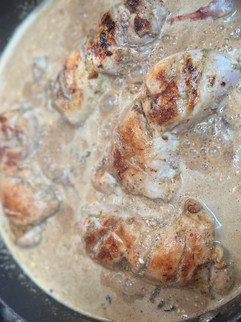forbidden rice with roasted chicken
- FH
- Sep 17, 2022
- 2 min read
my black rice cooked with chicken stock and black garlic; dashi braised carrots, daikon with beets, avocado mousse; french-style roasted chicken with aromatic asian spices...

forbidden rice
"Black rice (also known as forbidden black rice or emperor’s rice) is used in traditional Chinese medicine. It was once reserved only for the wealthy and powerful to ensure their health and long life. No one else was allowed to eat it.
Fortunately, that’s no longer the case, and black rice is widely available. Early research suggests that black rice is even more powerful than blueberries in its antioxidant effects (if you can imagine that). It may also help boost immunity and protect your body against cardiovascular disease, diabetes and other conditions." -- Cleveland Clinic
"There are several varieties of black rice available today. These include Indonesian black rice, Philippine heirloom balatinaw black rice and pirurutong black glutinous rice, and Thai jasmine black rice. Black rice is known as chak-hao in Manipur, India.
In Bangladesh, it is known as kalo dhaner chaal (black paddy rice) and used to make polao or rice-based desserts. The bran hull (outermost layer) of black rice contains one of the highest levels of anthocyanins found in food. The grain has a similar amount of fiber to brown rice and like brown rice, has a mild, nutty taste." -- Wikipedia
behind the scene...
I often find myself loosely following Japanese cooking principles regardless of my dishes.
what are the principles of japanese cuisine?
"Washoku (Japanese food) differs from Yoshoku (Western food) in many respects. For centuries, Washoku’s philosophy has been based on five principles - five being essential to Japanese Buddhism as it represents the five elements of Earth, Water, Fire, Wind and Energy. These five principles of Japanese cuisine include five colours, five flavours, five cooking methods, five senses, and five reflections.
five colors
Since the 6th century when Buddhism began in Japan, the five colours of white, black, red, green and yellow have been used not only in religious architecture and artwork but also in food. It makes sense that the more colours you have on your plate, the healthier and more nutritious your meal will be.
five flavors
According to the five principles, Japanese meals should contain a balance of salty, bitter, sweet, sour and savory or ‘umami’. Umami is that elusive quality that is usually obtained by adding dashi (stock made from konbu and katsobushi) for example, to various elements of Japanese cuisine such as miso soup, ramen, dressings and marinades.
five senses
“We eat with our eyes” is a saying in Japan. Since ancient times when food was scarce, meals were prepared with small but visually appealing portions. So although the sense of taste is important, so is the stimulation of smell, sound, touch, and especially sight. Since visual presentation is so essential to the enjoyment of Japanese food, so is the tableware that is used to serve the meal."


























コメント